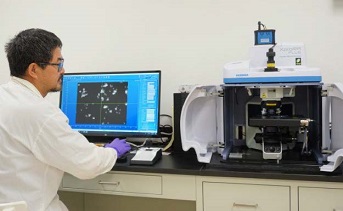International study to inform State microplastics policy

The State Water Resources Control Board has begun working to develop a draft policy requiring microplastics to be monitored in drinking water following an international, SCCWRP-facilitated study that evaluated multiple methods for measuring microplastics in aquatic environments.
The microplastics monitoring policy, expected to be released by State Water Board staff in draft form by the end of May, will specify how California should monitor microplastics in drinking water over an initial four-year period.
The development of the draft policy is being informed by an international study spanning 40 laboratories in six countries that examined precision, repeatability, cost and other issues associated with five different measurement methods: Raman spectroscopy, Fourier-transform infrared spectroscopy (FTIR), stereoscopy, stereoscopy with staining, and Pyrolysis-GCMS (gas chromatography/mass spectrometry).
The draft microplastics monitoring policy could be considered for State Water Board adoption as early as July.
Microplastics contamination is a growing management concern worldwide, with researchers finding microplastic particles in nearly every water body around the globe, although little is known about how they impact the health of humans and wildlife that inadvertently ingest them. Treatment processes are generally thought to be effective at reducing microplastics levels in drinking water.
During the method comparison study, the international research team developed SOPs (standard operating procedures) for the five measurement methods, as well as recommendations for how California could develop a formal statewide process for accrediting laboratories that measure microplastics in drinking water.
The draft microplastics monitoring policy will enable the State Water Board to meet a legislative deadline this year to begin routinely monitoring microplastics in drinking water. The California Ocean Protection Council has a similar legislative deadline to develop capacity to monitor microplastics in the coastal ocean by the end of 2021.
The international research team expects that its suggested monitoring framework and laboratory best-practices recommendations for drinking water will be largely transferrable to the ambient environment – with some modifications. The main difference is that samples collected in the coastal ocean and other water bodies will require additional processing steps before microplastics levels and types can be accurately quantified.
International research participants view this work as a precedent-setting framework for how to improve the accuracy and comparability of microplastics measurement methods worldwide.
By the end of the summer, researchers anticipate reaching consensus on the effectiveness of these methods for measuring microplastics in seawater, sediment, and fish tissue samples. All of the findings and recommendations will be captured in journal manuscripts.
Microplastics are plastic particles that can be as small as 1 micron. Because they can be difficult to distinguish from other particles like plant material and cloth fibers using light microscopy, multiple measurements have been developed.
Until the international method standardization study co-facilitated by SCCWRP, the relative effectiveness of these methods had never been compared in a side-by-side evaluation.
Last fall, SCCWRP began working to build international expert consensus on the health-based thresholds at which microplastics of different sizes, shapes and compositions can be expected to trigger adverse effects in wildlife and humans. The findings from this workshop are expected to be finalized later this year.
For more information, contact Dr. Charles Wong.
More news related to: Emerging Contaminants, Top News, Trash Pollution